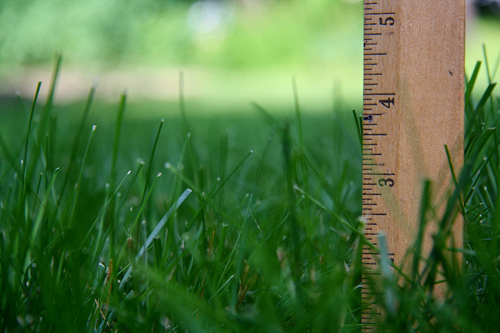The ‘One-Third Rule’ of Lawn Mowing
 You may have heard of the ‘one-third rule’ in reference to lawn mowing. This rule says that you should never remove more than one-third of the leaf blade during any one lawn mowing. For example, the recommended mowing height for Kentucky Bluegrass is 2 inches. Therefor, the height of the grass should not exceed 3 inches before it is mowed back to 2 inches.
You may have heard of the ‘one-third rule’ in reference to lawn mowing. This rule says that you should never remove more than one-third of the leaf blade during any one lawn mowing. For example, the recommended mowing height for Kentucky Bluegrass is 2 inches. Therefor, the height of the grass should not exceed 3 inches before it is mowed back to 2 inches.
Here’s a simple explanation of why the one-third rule is beneficial: Turfgrasses, like other green plants, manufacture their own food by the process of photosynthesis. This process utilizes sunlight, which is absorbed through the leaf of the grass plant, to convert carbon dioxide from the air into sugars. When more than one-third of the leaf blade is removed during a single mowing, there is suddenly less leaf area remaining to absorb sunlight and continue the process of photosynthesis. Consequently, the grass plant produces less food for itself, resulting in a weaker plant that’s susceptible to disease and insect damage.
Cutting more than one-third of the grass plant not only weakens the plant, it inhibits the growth of the roots, creating a small, shallow root system. During the dry summer months, these shallow roots can become dried out, eventually killing the plant. Grass that is allowed to grow tall will have strong, large root system below ground that can better withstand dry periods.
Depending on the health of your grass and the weather, it may be necessary to mow your lawn twice a week during the fastest growth periods to avoid taking off more than one-third of the leaf blade. Use these charts as guides for determining when to mow and how much to remove.
Want to learn more about the DR Power Equipment line-up?
Order your FREE catalog!

What's inside
- Information about the full line of DR equipment
- Money-saving promotions
- Product ordering information